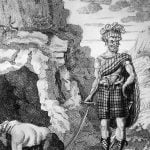CONTAINS SENSITIVE MATERIAL.
in Scotland in the 16th century who were reportedly executed for the mass murder and cannibalization of over 1000 people.
The story appears in The Newgate Calendar, a crime catalogue of Newgate Prison in London. While historians tend to believe Bean never existed or that his story has been greatly exaggerated, it has passed into local folklore and become part of the Edinburgh tourism circuit.
Legend
According to The Newgate Calendar, Alexander Bean was born in East Lothian during the 16th century. His father was a ditch-digger and hedge-trimmer and Bean tried to take up the family trade, but quickly realized that he had little taste for honest labour.
He left home with a vicious woman named “Black” Agnes Douglas, who apparently shared his inclinations and was accused of being a witch. After some robbing and the cannibalization of one of their victims, the couple ended up at a coastal cave in Bennane Head between Girvan and Ballantrae where they lived undiscovered for some 25 years. The cave was 200 yards deep and the entrance was blocked by water during high tide.

Sawney and Agnes produced eight sons, six daughters, 18 grandsons and 14 granddaughters. Various grandchildren were products of incest between their children.
Lacking the inclination for regular labour, the Bean clan thrived by laying careful ambushes at night to rob and murder individuals or small groups. The bodies were brought back to the cave where they were dismembered and eaten. Leftovers were pickled in barrels and discarded body parts would sometimes wash up on nearby beaches as part of the clan’s way of making the people think a wild animal was responsible.
The body parts and disappearances did not go unnoticed by the local villagers, but the Bean clan stayed in their cave by day and took their victims at night. The Bean clan was so secretive that the villagers were unaware of the murderers living nearby.
As more significant notice was taken of the disappearances, several organized searches were launched to find the culprits. One search took note of the cave but the men refused to believe anything human could live in it. Frustrated and in a frenetic quest for justice, the townspeople lynched several innocents and the disappearances continued. Suspicion often fell on local innkeepers since they were the last known to have seen many of the missing people alive.
One fateful night, the Bean clan ambushed a married couple riding from a fayre on one horse, but the man was skilled in combat, thus he deftly held off the clan with sword and pistol. The Bean clan fatally mauled the wife when she fell to the ground in the conflict. Before they could take the resilient husband, a large group of fayre-goers appeared on the trail and the Beans fled. The fayre-goers took the survivor to the local magistrate who was informed of this experience.
With the Beans’ existence finally revealed, it was not long before the King (likely James VI of Scotland in tales linked to the 16th century, though other tales are from the 15th) heard of the atrocities and decided to lead a manhunt with a team of 400 men and several bloodhounds. They soon found the Bean clan’s previously overlooked cave in Bennane Head thanks to the bloodhounds. Upon entering the cave by torchlight, the searchers found the Bean clan surrounded by human remains with some body parts hanging from the wall, barrels filled with limbs, and piles of stolen heirlooms and jewellery.
There were two versions on what happened next:
The most common of the two is that the Bean clan was captured alive where they gave up without a fight. They were taken in chains to the Tolbooth Jail in Edinburgh, then transferred to Leith or Glasgow, where they were promptly executed without trial as they were seen as subhuman and unfit for one. Sawney and his fellow men had their genitalia cut off and thrown into the fires, their hands and feet severed, and were allowed to bleed to death, with Sawney shouting his dying words: “It isn’t over, it will never be over.” After watching the men die, Agnes, her fellow women, and the children were burned alive on the stakes from which they were tied to. This recalls, in essence, if not in detail, the punishments of hanging, drawing and quartering decreed for men convicted of treason, while women convicted of the same were burned. There was another claim that gunpowder was placed at the entrance of their cave where they faced the fate of suffocation.
The town of Girvan, located near the macabre scene of murder and debauchery, has another legend about the Bean clan. It is said that one of Bean’s daughters eventually left the clan and settled in Girvan where she planted a Dule tree that became known as “The Hairy Tree.” After her family’s capture and exposure, the daughter’s identity was revealed by angry locals who hanged her from the bough of the Hairy Tree.




A charming chap! lol
lmao an understatement Mary lol xx thanks.